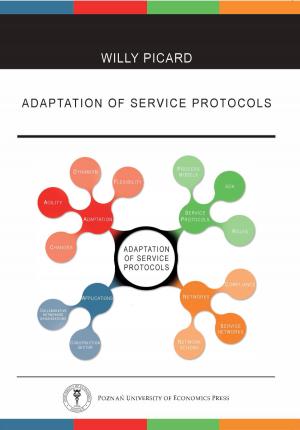
e-ISBN:
Edition: I
Publication date: 2013
First publication date: 2013
Pages: 262
Print: paperback
Electronic version:
Format: B5
License : commercial
last week: 4
last 3 months: 108
Willy Picard
Adaptation of service protocols
Availability and purchase
Print version(PWN bookstore)
*Clicking the button takes you to an external open access or selling platform.
Picard, W. (2013). Adaptation of service protocols. Poznań University of Economics and Business Press.
Introduction
Acknowledgements
I.THE PROBLEM
1.BACKGROUND
1.1. Networks
1.1.1. Fundamental Definitions
1.1.2. Representations of Networks
1.1.3. Social Network Analysis
1.1.4. Social Requirements
1.2. Service Orientation
1.2.1. Service-Oriented Architecture(s)
1.2.2. Web Services
1.3. Computer Support for Human Interactions
1.3.1. Workflow Management Systems
1.3.2. Business Process Modelling
1.3.3. Adaptive Case Management
2. ADAPTATION MODELS AND METHODS
2.1. Classification of Adaptation Models and Methods
2.2. Adaptation of Complex Systems
2.2.1. Characteristics of Complex Systems
2.2.2. Examples of Complex Systems
2.2.3. Network-based Approaches
2.2.4. Agent-based Approach
2.3. Adaptation of User Interfaces
2.3.1. Context-Aware Development Approach
2.3.2. Model-based Development Approach
2.4. Adaptation of Business Processes
2.4.1. Process Lifecycle in Process Aware Information Systems
2.4.2. Adaptation vs. Flexibility vs Evolution
2.4.3. Fe ADEPT Project
2.4.4. Fe “Pockets of Flexibility” Approach
2.4.5. Adaptive Service-Oriented Architecture
2.5. Evaluation of Adaptation Models and Methods
3. RATIONALE FOR THE ADAPTATION OF SERVICE PROTOCOLS
3.1. Motivation
3.2. Requirements
II. THE PROPOSED SOLUTION
4. SERVICE PROTOCOLS
4. 1. Fe Concept of a Service Protocol
4. 1. 1. Example 1: Clearance of a Construction Site
4. 1. 2. Key Issues
4. 1. 3. Goals of Service Protocols
4. 1. 4. Requirements for Service Protocols
4. 2. Fundamental Definitions
4. 2. 1. Object-oriented Graphs
4. 2. 2. Processes
4. 2. 3. Services
4. 3. Formal Model of Service Protocols
4. 3. 1. Overview of Service Protocols
4. 3. 2. Service-Oriented Summary of a Process Model
4. 3. 3. Service Network Schema
4. 3. 4. Service Protocols
4.4. Summary
5. ADAPTATION OF SERVICE PROTOCOLS
5.1. Fe Concept of Adaptation of Service Protocols
5.1.1. Example 2: Removal of Dangerous Chemicals
5.1.2. Key Issues
5.1.3. Goals of the Adaptation of Service Protocols
5.1.4. Requirements for the Adaptation of Service Protocols
5.2. Formal Model of Adaptation of Service Protocols
5.2.1. Overview
5.2.2. Meta-Protocols
5.2.3. Adapting Statements
5.3. Fe Meta-Protocol Markup Language (MPML)
5.3.1. Data Model
5.3.2. Meta-Protocol Pointers
5.4. Summary
III. APPLICATIONS
6. AGILE COLLABORATIVE NETWORKED ORGANIZATIONS
6.1. Collaborative Networked Organizations
6.1.1. Rationale for Collaboration among Organizations
6.1.2. Organizational Structures Supporting Collaboration among Organizations
6.1.3. Definition of Collaborative Networked Organizations
6.2. Service-Oriented Virtual Organization Breeding Environments
6.2.1. Virtual Organization Breeding Environments
6.2.2. Fe Service-Oriented Architecture Perspective
6.2.3. Definition of Service-Oriented Virtual Organization Breeding Environment
6.2.4. Classification of Services in a Breeding Environment
6.3. Agility in Service-Oriented Virtual Organizations Breeding Environments
6.3.1. Agile Creation of Collaborative Networked Organizations
6.3.1. Prescriptive modelling
6.4. Summary
7. AGILE CONSTRUCTION SUPPORT FOR REAL-ESTATE DEVELOPERS
7.1. Selected Characteristics of the Construction Sector
7.1.1. Complexity of the Development Process
7.1.2. Heterogeneity of Real-Estate Developers
7.2. Modelling Interactions during the Construction Phase
7.2.1. Characteristics of Interactions during the Construction Phase
7.2.2. Contract-based Service Protocols
7.3. Fe ErGo System
7.3.1. Overview of the ErGo System
7.3.2. ErGo Applications
7.3.3. Architecture
7.3.4. Implementation
7.4. Summary
8. CONCLUSIONS
Appendix 1. Overview of the Meta-Protocol Markup Language
Appendix 2. XML Schema of the Meta-Protocol Markup Language (MPML)
Appendix 3. An Example of a Meta-Protocol Serialization
Bibliography
Index
List of Figures
List of Tables
List of Listings
The originality of the proposed solution comes from the interdisciplinary nature of service protocols and their adaptation based on the integration of the process approach, the service-oriented paradigm, and networks, especially social ones. Another original aspect of Picard's approach is the fact that the proposed adaptation method is both normative and collaborative, encompassing human factors, such as tacit knowledge and social relations, that are not supported in purely technical systems.
From a review by Professor Jerzy Brzeziński
The originality of the results of Picard's works comes from a generalization of the serviceoriented paradigm to support the collaboration of people, information systems and/or organizations. [ ... ] Picard demonstrates that protocols are a universal approach that can be applied to both global and local organizations.
From a review by Professor Jerzy Świątek


